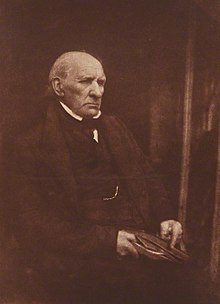John Gladstone | |
|---|---|
 Gladstone c. 1843-48 | |
| Member of Parliament for Lancaster | |
| In office 1818–1820 | |
| Preceded by | John Fenton-Cawthorne |
| Succeeded by | John Fenton-Cawthorne |
| Member of Parliament for Woodstock | |
| In office 1820–1826 | |
| Preceded by | Sir Henry Dashwood |
| Succeeded by | Marquess of Blandford |
| Member of Parliament for Berwick-upon-Tweed | |
| In office 1826–1827 | |
| Preceded by | Sir Francis Blake |
| Succeeded by | Sir Francis Blake |
| Personal details | |
| Born | John Gladstones 11 December 1764 Leith, Midlothian |
| Died | 7 December 1851 (aged 86) Fasque House, Kincardineshire |
| Resting place | St. Andrew's Chapel, Kincardineshire |
| Political party | Tory |
| Spouse(s) | Jane Hall (m. 1792–1798) Anne MacKenzie Robertson (m. 1801–1835) |
| Children | |
| Parents |
|
Sir John Gladstone, 1st Baronet, FRSE (11 December 1764 – 7 December 1851) was a Scottish merchant, planter and Tory politician best known for being the father of British Prime Minister William Ewart Gladstone. Born in Leith, Midlothian, through his commercial activities he acquired ownership over several slave plantations in the British colonies of Jamaica and Demerara-Essequibo; the Demerara rebellion of 1823, one of the most significant slave rebellions in the British Empire, was started on one of Gladstone's plantations.
After the passage of the Slavery Abolition Act 1833 by the Parliament of the United Kingdom, he received the largest of all compensated emancipation payments made via the Slave Compensation Act 1837 for the loss of his slaves. Gladstone proceeded to expel the majority of the newly emancipated freedmen from his plantations and imported large numbers of indentured servants from British India as part of the Indian indenture system. During this period, he also sat in Parliament from 1818 to 1827. Dying in 1851, Gladstone's involvement in slavery heavily influenced the proslavery thought of his son during his early political career.